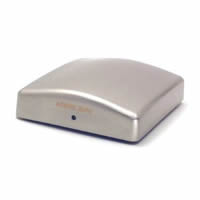Acoustic Revive’s RR-777
|
Mike Silverton [November 2012.]
When I left StereoTimes.com, I was obliged to return an assortment of Stein Music peripherals on long-term loan: four H2 Harmonizers on stands, Magic Blue Diamonds, Magic Diamonds, and Magic Stones. (Scattered about the listening room, the “Magic” bric-a-brac is said to act as Harmonizer enhancements. You can’t hold me accountable for the names of these things. See StereoTimes.com for my report.) Long before my time with Stein Music’s weird-science equipage, I’d been using another, remarkably effective — and remarkably mystifying — peripheral, the RR-77 Ultra-Low-Frequency Pulse Generator, also called the Schumann Resonance Generator, conceived and executed by Ken Ishiguro, Acoustic Revive’s main man. (The Schumann Resonance is a global phenomenon within Earth’s magnetic field, so named after the German physicist who postulated its existence. Wikipedia gives a good account.) The RR-77’s effectiveness was easily tested. One simply turned it off. Absent its participation, the somewhat diminished soundfield relinquished a touch of vibrancy and texture. The presentation was less lifelike. And I was far from the only audiophile who loved the RR-77. As did others of my obsessive ilk, I replaced the supplied wall-wart power supply with a more substantial linear power supply from KingRex, a Taiwanese manufacturer of audio components. In the main I operated the RR-77 along with the Stein Music pieces in something like contentment. A number of months back — I can’t be precise — Ken Ishiguro replaced the RR-77 with the RR-777, which, according to Yoshi Hontani, my Japanese contact, produces a pulse four times as powerful as that of its predecessor, and with a lower noise floor. (Lest I mislead, the RR-77 and RR-777 make no sound of their own. The pulse is electronic. I surmise that the lower noise floor allows for a cleaner pulse. Just a guess.) In covering the RR-777 in StereoTimes.com, I addressed Yoshi-san’s statement regarding the new unit’s potency by agreeing that it’s likely the more powerful. These present comments allow me to inflate an understatement. I relinquished the Stein Music ensemble reluctantly. The sense of loss was short-lived. I’ve since determined that I ought to have spent more time in listening for differences between the RR-77 and its successor with the Harmonizers off and removed from the room, along with the Diamonds and Stones. The RR-777 alone, absent competition, delivers an enlightening kick in the pants. On its high perch — a corner book tower — this small, unprepossessing box accomplishes wonders: a greatly expanded, more proximate, more richly endowed soundfield. A well-recorded string quartet is as if in the room, likewise a well-recorded piano. Good productions of chamber, jazz, and larger-scale works are similarly rich in impact and detail. The RR-777 is a David among Goliaths. My interest in audio, with breaks in continuity, began in the mono era. In all that time I’ve not encountered stand-alone devices as effective and, to be honest, as mysterious as these endearing pulse generators. In the way of a postscript, Yoshi-san tells me in a recent email that demand for the RR-777 exceeds production. I’m not surprised. Acoustic Revive RR-777, $650 USD
[More Mike Silverton]
[More
Audio]
[Previous Article:
And What, Pray, of Opera, You Ask]
[Next Article:
String Theory 10: 23 Quartets, etc.]
|
